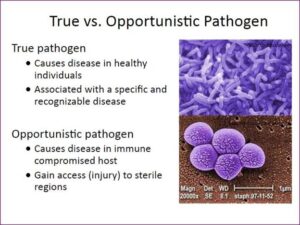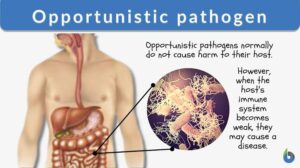Back to: MICROBIOLOGY 100 LEVEL
Welcome to class!
My brilliant scholar, you’re most welcome again! Today, we’re talking about something very important in understanding how diseases happen—Opportunistic vs. True Pathogens. Don’t worry, I’ll explain it to you just like you’re hearing it from your big cousin during a gist session after school!
Opportunistic Vs. True Pathogens
What Are Pathogens?
First, pathogens are microorganisms that cause disease. This can include bacteria, viruses, fungi, and parasites. But not all pathogens act the same way. Some are always dangerous, while others only cause trouble under certain conditions.

Let’s think of it like visitors in your house. Some come in and cause problems immediately (true pathogens), while others behave well until the opportunity comes when no one is watching (opportunistic pathogens). Now let’s break it down clearly.
True Pathogens
These are the serious troublemakers. They can cause disease in any healthy person, even when the immune system is strong and active.
Examples of true pathogens include:
Mycobacterium tuberculosis – causes tuberculosis.
Plasmodium falciparum – causes malaria.
Salmonella typhi – causes typhoid fever.
So imagine someone who walks into a peaceful compound and starts throwing stones, whether or not the gate is locked. That’s a true pathogen—it doesn’t wait for your defences to be weak.
Opportunistic Pathogens
These are usually harmless organisms that live in or around the body. But when the opportunity arises—like when your immune system is weak, or there’s a wound—they strike and cause disease.
Examples include:
Candida albicans – normally lives in the mouth or vagina but can cause thrush when immunity is low.
Escherichia coli (E. coli) – lives in the gut but can cause urinary infections if it enters the wrong place.
Staphylococcus epidermidis – harmless on the skin but may cause infection if it enters through surgery wounds.
So, think of them like calm neighbours who turn into noise makers only when there’s no landlord around. They take advantage of the situation.

Imagine your immune system is like a school security guard. True pathogens will jump the fence and cause chaos during school hours, no matter how alert the guard is. Opportunistic pathogens will behave until the guard goes home—then they start sneaking into the school to steal meat pies and break windows.
Summary
- Pathogens are disease-causing organisms.
- True pathogens can cause disease in anyone, even healthy people.
- Opportunistic pathogens only cause disease when the body’s defences are weak.
- Knowing the difference helps doctors treat infections better and protect vulnerable patients.
Evaluation
- What is a pathogen?
- Explain the difference between a true pathogen and an opportunistic pathogen.
- Give two examples of true pathogens.
- Give two examples of opportunistic pathogens.
- Why do opportunistic infections occur more in people with weak immunity?
You’ve just taken a powerful step in understanding how diseases work. You’re building a strong foundation for a future in medicine, microbiology, or health care. Stay curious and stay strong—Afrilearn is proud of your effort and growth. Let’s keep winning together!
